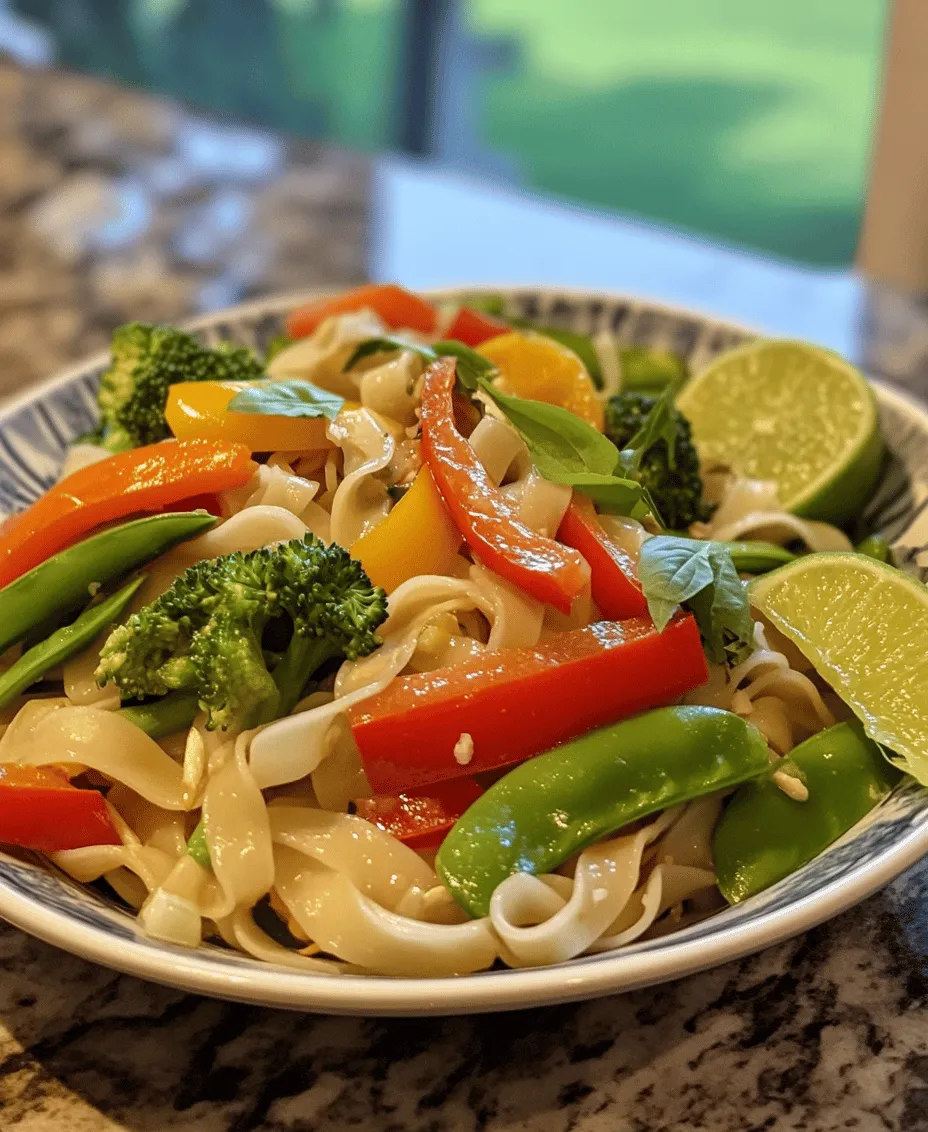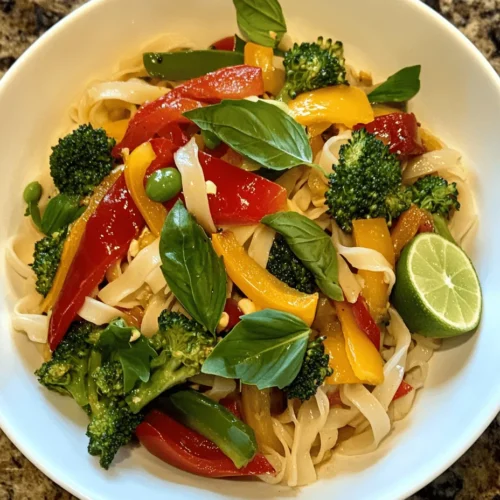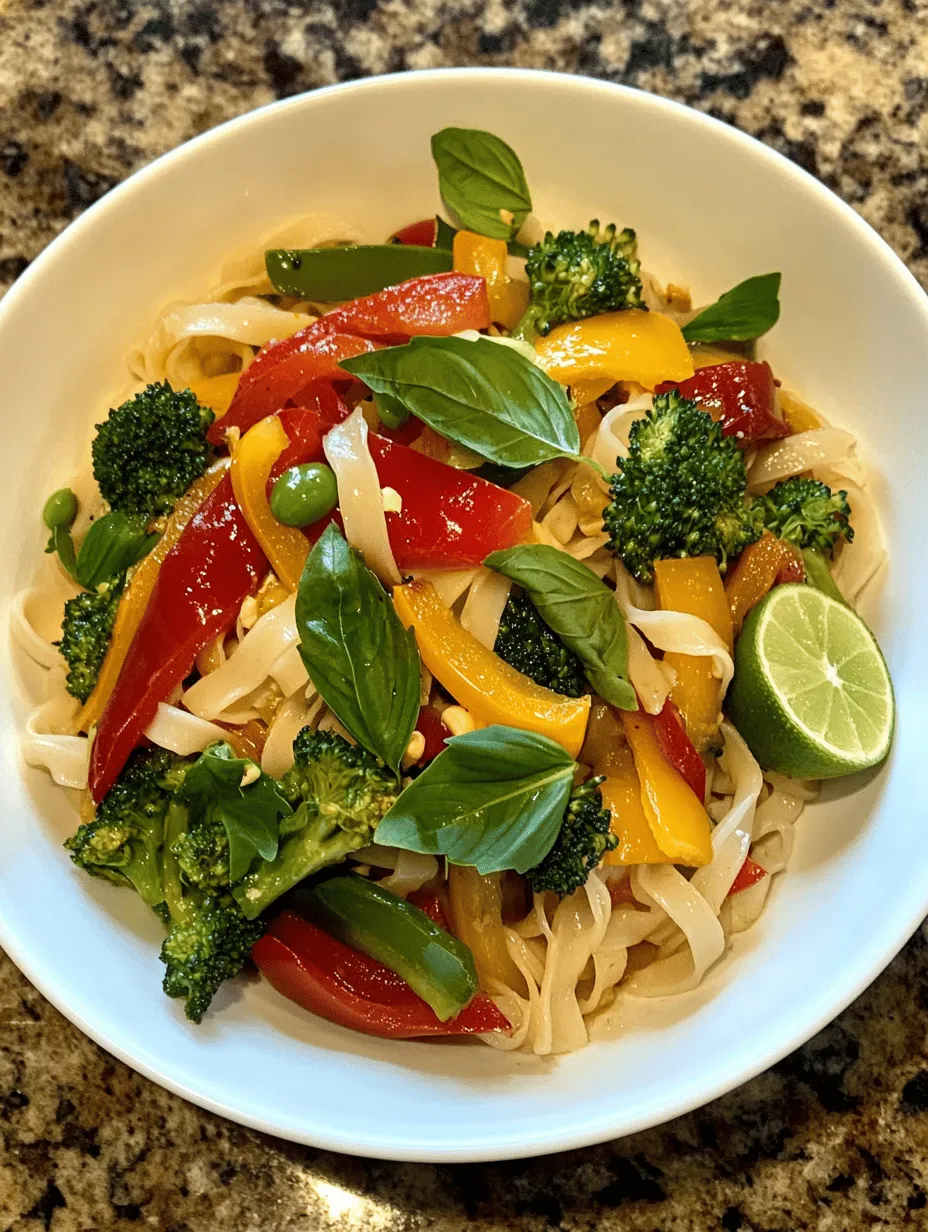Introduction
Thai cuisine has captivated food lovers around the globe with its harmonious blend of flavors, vibrant colors, and aromatic herbs. Renowned for its balance of sweet, sour, salty, and spicy elements, each dish tells a story rooted in the rich cultural tapestry of Thailand. Among the myriad of delicious offerings, Drunken Noodles, or Pad Kee Mao, stands out as a favorite, celebrated for its bold flavors and satisfying textures. This dish has become a staple not only in Thai restaurants but also in the hearts and kitchens of many around the world.
Drunken Noodles are a stir-fried noodle dish that embodies the essence of Thai cooking. Traditionally made with wide rice noodles, this dish is a perfect canvas for a variety of fresh ingredients, from colorful vegetables to proteins like chicken, beef, shrimp, or tofu. The beauty of this recipe lies in its versatility; it can cater to diverse dietary preferences while delivering an explosion of flavors in every bite. The combination of savory sauces, fresh herbs, and a hint of heat makes Drunken Noodles an unforgettable meal.
The Allure of Drunken Noodles
The name “Drunken Noodles” might raise eyebrows, but it carries a cultural significance that adds to the dish’s charm. It is said that the dish earned its intriguing name due to its popularity among late-night revelers seeking a hearty meal after a night of indulgence. The notion is that the bold flavors and satisfying nature of the noodles serve as the perfect remedy to counteract the effects of a night spent enjoying Thailand’s vibrant nightlife.
Originating from the bustling streets of Thailand, Drunken Noodles can be found in various forms, each region adding its unique twist. In Bangkok, you might encounter it with a spicier kick, while in the northern regions, a sweeter version may prevail. Regardless of the variation, the core ingredients remain consistent, allowing food lovers to experience the authentic essence of Thai flavors.
Drunken Noodles also play a significant role in Thai street food culture. Street vendors serve up steaming plates of these noodles to hungry customers, showcasing the vibrant culinary scene that defines Thailand. Whether enjoyed from a street cart or prepared at home, Drunken Noodles have become synonymous with comfort food, offering a taste of Thailand’s dynamic food culture.
Ingredients Breakdown
To create the perfect Drunken Noodles, a thoughtful selection of ingredients is essential. Each component contributes to the overall flavor profile, texture, and nutritional value of the dish.
Wide Rice Noodles
The star of Drunken Noodles is undoubtedly the wide rice noodles, known as “sen yai.” These noodles are thicker than traditional vermicelli and provide a delightful chewiness that enhances the eating experience. When selecting rice noodles, look for fresh or dried varieties labeled specifically as wide rice noodles. The texture is crucial; they should be able to absorb the sauces while maintaining their integrity during cooking. To prepare, soak dried noodles in warm water until they soften, then drain before cooking.
Vegetables
Incorporating a variety of vegetables not only elevates the dish’s nutritional profile but also adds color and crunch. Common choices include bell peppers, broccoli, and snap peas. Bell peppers provide a pop of sweetness and vibrant color, while broccoli adds a satisfying crunch and is rich in vitamins C and K. Snap peas contribute a fresh, crisp texture, making them a perfect addition to this dish. Feel free to experiment with other seasonal vegetables to customize your Drunken Noodles.
Proteins
Drunken Noodles offer flexibility when it comes to protein choices. Traditional recipes often feature chicken or beef, but shrimp and tofu are excellent alternatives for those seeking seafood or plant-based options. Chicken breast tends to absorb the flavors of the sauce beautifully, while beef adds a hearty richness. Shrimp cooks quickly and lends a seafood essence to the dish, whereas tofu provides a satisfying texture and can easily take on the flavors of the accompanying sauces. Choose your preferred protein or mix and match for a delightful medley.
Sauces
Achieving umami in Drunken Noodles relies heavily on the right balance of sauces. A combination of soy sauce, oyster sauce, and fish sauce is key to creating a depth of flavor that is both savory and satisfying. Soy sauce provides a salty base, oyster sauce adds a hint of sweetness and richness, and fish sauce contributes a distinct umami flavor. Adjust the quantities to suit your taste preferences, ensuring that the sauce complements rather than overwhelms the dish.
Spices
No Thai dish is complete without a touch of heat and aromatic spices. Thai bird’s eye chilies bring a fiery kick to Drunken Noodles, while garlic adds depth and fragrance. Adjust the number of chilies based on your spice tolerance, and consider using fresh garlic cloves for the best flavor. Sautéing these aromatics at the right temperature will release their essential oils, enhancing the overall taste of the dish.
Step-by-Step Cooking Instructions
Ready to embark on your culinary adventure? Preparing Drunken Noodles is a straightforward process that yields delicious results. Follow these step-by-step instructions to master this flavorful dish.
Preparation of Rice Noodles
1. Soak the Noodles: Begin by soaking the wide rice noodles in warm water for about 30 minutes if using dried noodles. If you have fresh noodles, you can skip this step. The goal is to soften the noodles without cooking them completely, as they will be stir-fried later.
2. Drain and Rinse: Once softened, drain the noodles thoroughly and rinse them under cold water. This step prevents the noodles from sticking together during cooking.
3. Toss with Oil: To further prevent clumping, toss the drained noodles with a small amount of oil before setting them aside. This will help keep the noodles separate during the stir-frying process.
Sauce Creation
1. Mix the Sauces: In a small bowl, combine soy sauce, oyster sauce, and fish sauce. Start with 2 tablespoons of soy sauce, 1 tablespoon of oyster sauce, and 1 tablespoon of fish sauce. Adjust according to your taste preferences. For a vegan version, substitute the oyster sauce with a mushroom-based alternative.
2. Add Sweetness: If you prefer a touch of sweetness, consider adding a teaspoon of sugar or honey to the sauce mixture. This will balance the salty and savory notes.
3. Set Aside: Once mixed, set the sauce aside while you prepare the rest of the ingredients.
Sautéing Aromatics
1. Heat the Wok: Preheat a large wok or skillet over high heat until it is hot. Properly heating the wok is crucial for achieving the desired stir-fry texture.
2. Add Oil: Once the wok is hot, add a tablespoon of vegetable oil (or your preferred cooking oil) and swirl it around to coat the surface.
3. Sauté Garlic and Chilies: Add minced garlic and sliced bird’s eye chilies to the hot oil. Stir-fry for about 30 seconds, or until fragrant. Be careful not to burn the garlic, as it can become bitter.
4. Introduce Proteins: If using meat or shrimp, add it to the wok and stir-fry until it is cooked through. For tofu, cook until golden brown on all sides. This step will infuse the proteins with the aromatic flavors of garlic and chilies.
By following these initial steps, you’re well on your way to creating a delicious batch of Drunken Noodles. The combination of fresh ingredients, flavorful sauces, and aromatic spices will transport your taste buds to the vibrant streets of Thailand. Stay tuned for the next part of the recipe, where we will combine these elements for a mouthwatering result.

Vegetable Stir-Frying
To create the perfect Drunken Noodles, the first key step is sautéing the vegetables. This is where you will bring vibrant flavors and textures to your dish. Choose colorful vegetables such as bell peppers, carrots, and snap peas to create a visual feast. Begin by heating your wok or large skillet over medium-high heat, allowing it to warm thoroughly before adding any oil.
Once the pan is hot, add a tablespoon of vegetable oil. The oil should shimmer immediately, indicating that it is ready for stir-frying. Add your chopped vegetables in batches, starting with those that take longer to cook, such as carrots and bell peppers. Stir-fry for 1-2 minutes before adding quicker-cooking vegetables like snap peas or bean sprouts. The goal is to achieve a slight char on the vegetables while keeping them crisp and colorful.
Best Practices for Maintaining Vegetable Crispness and Color
To ensure that your vegetables remain crisp and vibrant, follow these best practices:
1. High Heat: Use high heat throughout the cooking process. This helps to sear the vegetables quickly, locking in moisture and flavor.
2. Cut Uniformly: Chop your vegetables into uniform sizes. This ensures even cooking and prevents some pieces from becoming overcooked while others are still raw.
3. Don’t Overcrowd: Avoid adding too many vegetables at once. Overcrowding the pan can lower the temperature, leading to steaming instead of stir-frying.
4. Quick Cooking: Stir-fry each batch for only 2-3 minutes. You want them to be tender-crisp, retaining their fresh flavor and color.
Time Management for Cooking Vegetables Perfectly
Time management is crucial for achieving perfectly cooked vegetables. Prepare all your ingredients before you begin cooking. This includes washing, peeling, and chopping vegetables, as well as measuring out any sauces or seasonings. When you’re ready to cook, follow this sequence:
1. Heat the wok and add oil.
2. Start with the denser vegetables (e.g., carrots, bell peppers).
3. After 2 minutes, add the quicker-cooking vegetables (e.g., snap peas, bean sprouts).
4. Stir continuously to prevent burning.
By timing each addition correctly, you ensure that all vegetables are cooked properly and retain their crispness.
Incorporating Protein
Once your vegetables are perfectly stir-fried, it’s time to add protein to your Drunken Noodles. Popular options include chicken, beef, shrimp, or tofu, catering to various dietary preferences.
Recommendations on Pre-Cooking Methods for Proteins
For a well-integrated dish, pre-cooking your protein is essential. Here are a few methods:
– Grilling: For chicken or beef, grill the meat until cooked through before slicing it into bite-sized pieces.
– Sautéing: For shrimp or tofu, sauté in a separate pan until golden and cooked through. This method allows them to develop a crispy exterior, enhancing texture.
– Marinating: Before cooking, marinate proteins in soy sauce, garlic, and a splash of lime juice for 30 minutes. This adds flavor and tenderness.
How to Ensure Even Distribution of Flavors
To ensure that the flavors of your protein permeate the dish, toss it with the vegetables in the wok. Use the following method:
1. Add the pre-cooked protein to the stir-fried vegetables.
2. Pour in any remaining marinade or sauce from the cooking process.
3. Stir-fry everything together for an additional 1-2 minutes to allow the flavors to meld.
4. Ensure that the protein is evenly distributed throughout the vegetable mixture before proceeding to add the noodles.
Combining Noodles and Sauce
The next step is to combine your noodles with the stir-fried vegetables and protein, along with the sauce that makes Drunken Noodles so delicious.
Techniques for Tossing Noodles and Sauce Without Breaking Them
To incorporate the noodles without breaking them, follow these techniques:
1. Soak and Drain: If using dry rice noodles, soak them in hot water until pliable, then drain. Avoid boiling them, as this can lead to mushy noodles.
2. Add Sauce First: Pour the sauce into the wok before adding the noodles to create a slippery surface that helps prevent sticking.
3. Gentle Tossing: Use two spatulas or a large fork to gently lift and toss the noodles with the sauce and other ingredients. This prevents breaking and ensures even coverage.
Tips on Achieving the Desired Consistency
To achieve the perfect consistency in your Drunken Noodles, consider the following:
– Adjust Sauce Amount: If the noodles seem dry, add a splash of water or broth to loosen them. Conversely, if the dish feels too wet, increase the heat to evaporate excess moisture.
– Taste as You Go: Adjust flavors by tasting the noodles as you mix. Add more soy sauce, chili paste, or lime juice to suit your preferences.
Final Touches with Basil
No Thai dish is complete without fresh herbs, and for Drunken Noodles, Thai basil is a must.
The Role of Fresh Herbs in Thai Cooking and Flavor Enhancement
Thai basil adds a unique flavor profile that complements the dish beautifully. Its slightly peppery taste and aromatic quality elevate the overall experience. Here’s how to incorporate it:
1. Add Fresh Basil: Just before serving, stir in a generous handful of fresh Thai basil leaves. The residual heat from the noodles will gently wilt the leaves, releasing their oils.
2. Garnish: Reserve some leaves for garnishing on top of the dish, enhancing both presentation and aroma.
Serving Suggestions
Presentation is key when serving Drunken Noodles. Here are some ideas to make your dish visually appealing:
– Plate Presentation: Serve the noodles in a large bowl or on a wide plate. Create a nest of noodles topped with the stir-fried vegetables and protein. Garnish with fresh basil and a slice of lime.
– Traditional Thai Pairings: Pair your Drunken Noodles with traditional sides like fresh spring rolls or a Thai cucumber salad. These dishes add a refreshing contrast.
– Beverage Pairings: Consider serving Thai iced tea or a light beer, which complements the spicy and savory flavors of the noodles.
To enhance your dining experience, serve lime wedges on the side. Squeezing fresh lime juice over the dish adds brightness and acidity, cutting through the richness of the sauce.
Nutritional Insights
Drunken Noodles can be a wholesome meal packed with nutrients. Let’s break down the nutritional profile:
– Carbohydrates: Rice noodles are a good source of carbohydrates, providing energy.
– Vitamins: Fresh vegetables contribute essential vitamins and minerals, enhancing the dish’s nutritional value.
– Protein: Depending on your protein choice (chicken, shrimp, tofu), you can also boost the protein content significantly.
Discussion on the Health Benefits of the Selected Ingredients
– Fresh Vegetables: Provide dietary fiber, vitamins A and C, and antioxidants.
– Thai Basil: Contains anti-inflammatory properties and is rich in essential oils that can promote health.
Tips for Making the Dish Healthier Without Sacrificing Flavor
To create a lighter version of Drunken Noodles without losing flavor:
1. Use Whole Wheat Noodles: Swap regular rice noodles for whole wheat or a gluten-free alternative for added fiber.
2. Reduce Oil and Sugar: Use less oil in stir-frying and opt for low-sugar sauces.
3. Increase Vegetables: Bulk up the vegetable content to make the dish more filling and nutritious.
Cultural Significance of Drunken Noodles
Drunken Noodles, or Pad Kee Mao, reflect the essence of Thai culinary traditions. This dish is celebrated for its bold flavors and vibrant ingredients, making it a popular choice in Thai cuisine.
Exploration of How This Dish Reflects Thai Culinary Traditions
Drunken Noodles exemplify the balance of flavors that Thai cooking is known for—spicy, sweet, salty, and sour. The use of fresh herbs and vegetables showcases the importance of fresh ingredients in Thai cooking.
The Dish’s Popularity in Thai Restaurants Worldwide
You can find Drunken Noodles on the menu of most Thai restaurants, making it a beloved dish among locals and visitors alike. Its popularity stems from its comforting nature and the versatility of ingredients.
Personal Anecdotes or Stories from Those Who Have Enjoyed Drunken Noodles in Thailand
Many travelers recount their experiences of enjoying Drunken Noodles at vibrant street food stalls in Thailand. The aroma of spices and fresh herbs wafts through the air, drawing in eager diners. Often served in bustling markets, it is a dish that evokes memories of communal dining and culinary adventure.
Conclusion
Creating and enjoying Drunken Noodles at home is a rewarding experience that allows you to embrace the flavors of Thai cuisine. As you master this recipe, don’t hesitate to experiment with different proteins and vegetables to personalize the dish according to your tastes.
By immersing yourself in cultural dishes like Drunken Noodles, you not only expand your culinary repertoire but also appreciate the rich tapestry of flavors and traditions that come from around the world. Embrace the joy of cooking and the satisfaction of sharing this delightful dish with family and friends.



